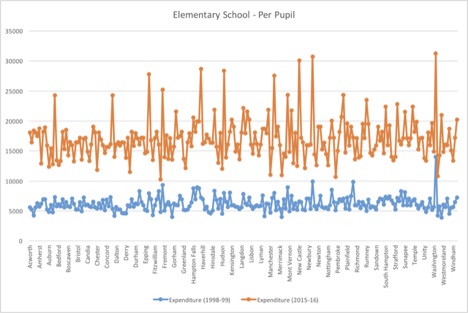The Democrat-controlled Commission to Study School Funding has issued its final report. There’s no chance that a Republican-controlled government is going to implement the recommendations of this report. (At least, one hopes that’s the case, but as Winnie-the-Pooh would say, you never can tell with Republicans.)
But there is a crucial aspect of the report that deserves to be discussed before it sinks like the Titanic.
How many people noticed that the goal of ‘adequacy’ was deftly replaced in the report with the goal of ‘equity’? That the whole enterprise was being reframed — through the magic of Design Thinking — as an exercise in charity, rather than as an exercise in the preservation of a free society?
Here are two important things to know about equity. The first, and more important, is that ‘equity’ is incompatible with the notion of a ‘free society’.
Why? Because in a free society, people will value different things, have different priorities, and make different decisions based on those values and priorities… and the freedom to do these things must necessarily lead to inequities, whether we like it or not. If equity is the goal, then freedom is an obstacle that must be eliminated, or at best worked around.
The second thing to know about equity is that you can’t get to it by raising everyone up. This is just common sense, as it requires making luck illegal.
But we don’t have to rely on common sense, because we have two decades of data showing what happens when you take that approach with schools:
Put simply, every district is now a rich district. That is, every district is now spending more, adjusted for inflation than any district (except Waterville Valley) was spending before Claremont. How much more? About $10 thousand per student, per year, on average.
Did that make things more equitable? It did not.
Did it improve educational outcomes? It did not.
Did it waste a lot of money? Oh, my, yes. How much money?
This is clearly just a ballpark figure, but with around 200,000 students in public schools in NH, spending an extra $10 thousand on each student is about $2 billion dollars per year that we might as well pile up and burn in the street.
And doing that for roughly 20 years brings the cumulative total to around $40 billion, give or take.
Kurt Vonnegut nailed it 60 years ago in his short story ‘Harrison Bergeron’, which begins:
THE YEAR WAS 2081, and everybody was finally equal. They weren’t only equal before God and the law. They were equal every which way. Nobody was smarter than anybody else. Nobody was better looking than anybody else. Nobody was stronger or quicker than anybody else. All this equality was due to the 211th, 212th, and 213th Amendments to the Constitution, and to the unceasing vigilance of agents of the United States Handicapper General.
If what we really want is equity, then what we should be doing is lowering ceilings, not trying to raise floors.
What would that look like? Quite simply, if there is any public school, anywhere in the state, that doesn’t offer something — whether that’s AP courses, or a varsity football team, or a program in robotics, or courses in welding or CNC machining, or a dedicated computer for every student — then no public school would be allowed to offer it. And no student, having reached an agreed-upon level of achievement, would be allowed to remain in school.
Interestingly, if we took this seriously, we would end up with schools where virtually all the attention of students would be focused on mastering fundamental, foundational skills like reading, mathematics, and reasoning, and virtually all of the efforts of staff would be directed toward supporting that.
With no other distractions, there would at least be a chance that most students could reach proficiency in those subjects, which isn’t the case now. This would accomplish several important things:
(1) It would let those students successfully pursue any other educational avenues that they want, by positioning them to make effective use of the pedagogy that literally falls from the sky, 24 hours a day, 7 days a week, everywhere that cell service is available.
(2) It would put us way ahead of where we are now, in terms of academic achievement.
(3) It would save taxpayers a boatload of money.
(4) It would align our efforts with the plain meaning of Article 83 of the state constitution, which — together with Article 2-a — declares that free people must be both armed and educated if they want to remain free.
To be clear, I think equity is the wrong goal to be pursuing. As Jefferson might put it, freedom without equity is preferable to equity without freedom.
But if we really want equity to be the goal, then let’s pursue it seriously — through the judicious application of handicaps — rather than by continuing to fart around with funding formulas, an approach which both common sense and decades of data tell us is doomed to failure.

